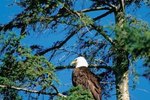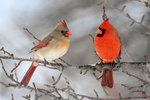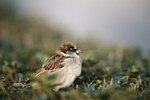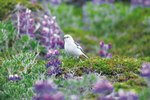
Minnesota plays host to more than 200 species of breeding birds, although some avian breeders don't stay around long enough to nest and raise their offspring in the state. Breeding habitats include evergreen and deciduous forests, wetlands and open uplands. Seven finch species breed in Minnesota, mostly in evergreen forests. American goldfinch and purple finch sightings top the Department of Natural Resources' statewide sighting list.
American Goldfinch
Minnesota birdwatchers can enjoy American goldfinch feeder sightings all year long. While these bright yellow birds are common in Minnesota during the summer, the hardy little finches also brave the state's harsh winter weather. American goldfinches don't nest until July or August, when many other birds are gearing up for winter migrations. These opportunistic little finches snatch up late summer's plentiful wild seeds, even dining on the coveted thistle seeds when available.
Purple Finch
A purple finch's appearance and lilting warbling song make him easy to find in woodlands, parks and orchards. Purple finches are among the most visible finches, especially during spring migrations when a reddish-purple male displays his finery for his favorite female. During breeding season, purple finches frequent their Minnesota nesting spots before heading south to escape the region's frigid winters. Large groups of purple finches often gather at winter feeding stations, gorging themselves on sunflower seeds when this choice meal presents itself.
Evening Grosbeak
Evening grosbeaks have adopted a large portion of North America as their breeding grounds. These large finches breed across Canada, in Minnesota and south to California and the Mexican mountains. During the winter, evening grosbeaks inhabit suburban and deciduous woodland areas. Evening grosbeaks seem to have an unusual appetite for raw salt and sunflower seeds, as observers have seen a ravenous evening grosbeak consume almost 100 sunflower seeds in five minutes. These voracious eaters also feast on fruits, berries, insects and tree sap.
Red Crossbill
Red crossbills have developed a rather unorthodox method of retrieving seeds from evergreen tree cones. Unlike many other birds, red crossbills' beaks don't meet top to bottom, but instead cross over each other. Some crossbills' beaks cross right over left, while others' beaks cross left over right. This beak structure enables some red crossbills to feed upside down while others consume meals while standing upright. Red crossbills exhibit wide variations in beak size and body depending on their habitats' tree cones' sizes. While Minnesota contains a relatively small number of red crossbills, researchers have documented six subspecies in Wadena County, mostly spotted around a single tree.
Pine Siskin
Pine siskins often criss-cross North America in pursuit of suitable seed sources. These small brownish songbirds boast a hint of yellow on their tails and wings, coloring that's especially visible when the chatty siskins congregate around tree branch tips or display their plumage for mating. They even hang upside down to feed when they spy a really desirable seed source below them. Although pine siskins prefer a forest habitat, they're adaptable to thickets, fields and even gardens and backyards. They frequently visit bird feeders, especially during winter when naturally occurring seeds might be scarce. Surprisingly, pine siskins seem oblivious to the northern Minnesota cold, gathering around bird feeders in the Sax-Zim Bog, known for its winter bird sightings.
References
- Minnesota Department of Natural Resources: About the Breeding Bird List
- Minnesota Department of Natural Resources: Minnesota Breeding Bird Map List
- Minneapolis StarTribune: Outdoors Journal: American Goldfinch
- Audubon: Purple Finch
- WhatBird.com: Field Guide to Birds of North America: Evening Grosbeak
- Science Museum of Minnesota: Red Crossbill
- The Cornell Lab of Ornithology: All About Birds: Pine Siskin
- The New York Times: Travel: In a Minnesota Bog, A Festival of Birds: Siskins
Photo Credits
-
Jupiterimages/Photos.com/Getty Images
Writer Bio
Based in North Carolina, Felicia Greene has written professionally since 1986. Greene edited sailing-related newsletters and designed marketing programs for the New Bern, N.C. "Sun Journal" and New Bern Habitat ReStore. She earned a Bachelor of Science in business administration from the University of Baltimore.




